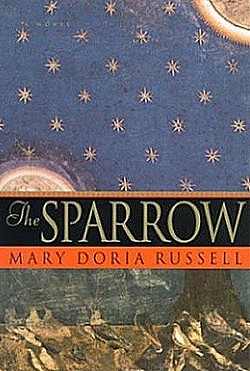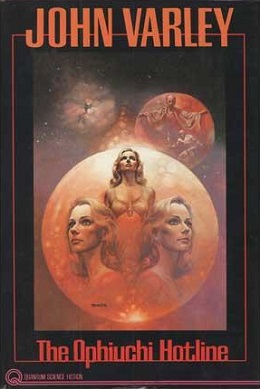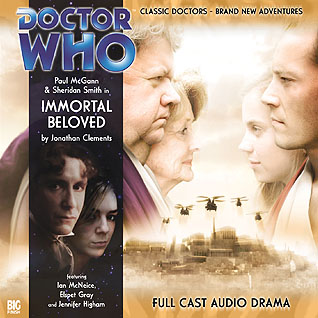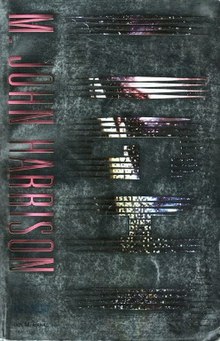Overview
The book centres on the lives of three individuals — the physicist (and serial killer) Michael Kearney, on the verge of a breakthrough in theoretical physics sometime in 1999; Seria Mau Genlicher, the cybernetically-altered female pilot of a "K-ship", and the ex-space pilot and adventurer Ed Chianese. Seria Mau and Ed's stories take place in the year 2400 AD.
The lives of these three individuals are linked in many ways, though most tangibly by the presence of a mysterious creature called The Shrander, who appears in many guises to all three characters throughout the novel (with anagrammatic names of Sandra Shen and Dr. Haends). They are also linked by the Kefahuchi Tract, a space-time anomaly described as "a singularity without an event horizon", an object of awe and wonder that has been the ruin of many civilisations attempting to decode its mysteries.
The Shrander takes many forms, most often with the body of an old woman in a maroon wool coat, with a horse's skull for a head which may be similar to its original form. Harrison appears to have taken his inspiration for this strange entity from the legend of the Mari Lwyd, a creature with a horse's skull for a head, bedecked in ribbons, that features in the ancient folklore of Gwent and Glamorgan.
Elements of Light originally surfaced in Harrison's short fiction, particularly the stories "The Horse of Iron and How We Can Know It" and "The Incalling". The former contains prototypes of the Shrander and Kearney characters, whilst the latter deals with the Sprakes, a clan of dubious urban magicians. Both stories are available in the collected volume of Harrison's short fiction, Things That Never Happen.
Characters
Michael Kearney strand (1999 AD)
Michael Kearney: A 40-year-old physicist and serial killer. Plagued by hallucinations of - or visitations from - a mysterious entity he calls "The Shrander".
Brian Tate: Kearney's research partner, whose dedication to his research into the physics of "decoherence free space" is eroding his marriage and, possibly, his sanity. Kearney and Tate's research ultimately paves the way for humanity to explore space.
Anna Kearney: Kearney's ex-wife, a psychologically brittle, (though eternally optimistic) woman of 40. When the novel begins, she is in a relationship, but the impromptu arrival of her ex-husband destroys this, and she and Michael begin their relationship again.
Valentine Sprake: A street drunk who first meets Kearney on an overground train, and guesses his terrible secret. The two become partners in magic and crime; it is hinted that Sprake has prophetic abilities, and his sister describes him as "one of the five most powerful magicians in London", a claim which Kearney mocks.
Seria Mau strand (2400 AD)
Seria Mau Genlicher: Seria Mau signed up to Earth Military Contracts at the age of 13, whereupon she was cybernetically fused to her K-ship, the White Cat. She subsequently went rogue and became a freelance assassin. Though she is in control of a ship of devastating capabilities, Seria Mau has not matured emotionally, and is prone to fits of murderous rage, lust and caprice.
Uncle Zip: A "tailor" (gene manipulator) based on the planet Motel Splendido, who deals in dubious merchandise. It is he who tells Seria Mau where she might find the space pilot Billy Anker.
Mona the Clone: A vain, empty-headed young woman who boards the White Cat with a team of salvagers. When they are killed, Seria Mau takes pity on her and allows her to live on board, though their relationship is fraught. It is heavily implied that "Mona" is one of the most common and fashionable "looks" for women in the galaxy, and the novel is filled with numerous versions of her.
Billy Anker: A decrepit "entradista" whom Seria Mau meets, rescues, and later murders. A daredevil pilot in his youth, he is a clone of Uncle Zip.
Ed Chianese strand (2400 AD)
Ed Chianese: A thrill-seeker, adventurer and "twink" (Virtual Reality addict) who finds work as a "futurist" (essentially a performing oracle) at a circus run by Sandra Shen.
Evie and Bella Cray: The Cray Sisters are notorious gangsters, to whom Ed owes money. Their hunt for him wrenches Ed from his various addictions and towards his true destiny.
Tig Vesicle: A "new man", one of a curious race of aliens who invaded Earth centuries ago. He and his wife Neena hide Ed when he is on the run.
Annie Glyph: a "rickshaw girl", genetically modified for the strength and speed required for long shifts pulling a rickshaw. Ed saves her life, and the two of them embark on an affair.
References and allusions
The novel is replete with references to Harrison's many interests - mountaineering, rock music, etc. In many ways, this is fitting for a novel that is, in part, about human beings and their endless capacity for re-use and re-invention. Song lyrics, references to old TV shows and numerous other allusions are dropped into the narrative at various points.
There are at least three allusions to the world of mountaineering in the book: the use of the word "benighted", often used by climbers to describe being trapped on a crag by encroaching darkness, the cruiser named Touching the Void a reference to the book of the same name by Joe Simpson and the remark by Chianese that "You don't get the tick unless you come back". There are also several references to The Stars My Destination by Alfred Bester, most notably the borrowed line about the vacuum of space "smelling of lemons". One character is named Otto Rank, presumably after the psychoanalyst. Seria Mau Genlicher's name is almost certainly a reference to Sarah Michelle Gellar, and at one point Kearney's partner Brian Tate reflects on watching reruns of Buffy the Vampire Slayer .
Several of the chapters are also named after rock songs or albums. Agents of Fortune is an album by Blue Öyster Cult, and "Tumbling Dice" is named after the Rolling Stones song. In addition, the street gang who are assigned to find Ed Chianese in New Venusport are called The Skeleton Keys of the Rain, after a Bob Dylan lyric. The Shadow Operators, ghosts of old code who congregate in human ships, are apt to quote old song lyrics, including Joe Jackson's "Is She Really Going Out with Him?".
There are also references to old BBC TV shows, particularly in the trash-talk exchanged between Seria Mau and the other K-Captain, Krishna Moire. Seria Mau, upon firing a missile at Moire's pod of ships, declares "Here's one I made earlier", a catchphrase from Blue Peter , and Moire later responds with "It's goodnight from me. And a fucking goodnight to you", a profane parody of one of the catchphrases of The Two Ronnies .
London locations
Many real London locations are utilised; Anna Kearney's flat is in Grove Park, near Chiswick; Kearney and Brian Tate's laboratory is in Bloomsbury; the offices of the venture capitalist that Tate sells his and Kearney's research to (and whom Kearney subsequently murders) is in Walthamstow, Kearney's private members club is in Greek Street, Soho; and Valentine Sprake and his family live in Kilburn. It is here where Kearney finds Sprake dead. Kearney first encounters The Shrander at Charing Cross, and meets a homeless woman who may or may not be her in Soho Square. Anna Kearney also follows Michael, at a distance, from Hammersmith, through Victoria to West Croydon, whereupon they discover the ultimate fate of Brian Tate.
The other strands often refer tangentially to Kearney's London; for instance, the backwater planet on which Seria Mau temporarily strands Mona the Clone is situated in a star system called Perkins' Rent, named after a street near Victoria.

Alice Bradley Sheldon was an American science fiction and fantasy author better known as James Tiptree, Jr., a pen name she used from 1967 to her death. It was not publicly known until 1977 that James Tiptree, Jr. was a woman. From 1974 to 1985 she also used the pen name Raccoona Sheldon. Tiptree was inducted into the Science Fiction Hall of Fame in 2012.

Michael John Harrison, known for publication purposes primarily as M. John Harrison, is an English author and literary critic. His work includes the Viriconium sequence of novels and short stories (1971–1984), Climbers (1989), and the Kefahuchi Tract trilogy, which consists of Light (2002), Nova Swing (2006) and Empty Space (2012).
Lazarus Long is a fictional character featured in a number of science fiction novels by Robert A. Heinlein. Born in 1912 in the third generation of a selective breeding experiment run by the Ira Howard Foundation, Lazarus becomes unusually long-lived, living well over two thousand years with the aid of occasional rejuvenation treatments. Heinlein "patterned" Long on science fiction writer Edward E. Smith, mixed with Jack Williamson's fictional Giles Habibula.

Sexual themes are frequently used in science fiction or related genres. Such elements may include depictions of realistic sexual interactions in a science fictional setting, a protagonist with an alternative sexuality, a sexual encounter between a human and a fictional extraterrestrial, or exploration of the varieties of sexual experience that deviate from the conventional.

Dr. Katherine Pulaski is a fictional medical doctor in the American science fiction television series Star Trek: The Next Generation. She served a rotation as the chief medical officer aboard the Federation starship USS Enterprise-D. During her time on the ship, her medical skills saved the lives of both Captain Jean-Luc Picard and Commander William Riker. She inadvertently caused Geordi LaForge to create a hologram of Professor Moriarty that became self-aware, after a bet involving the abilities of Lt. Commander Data. Pulaski seemed averse to most new technology and preferred to avoid the transporter, but was forced to rely on it to save her own life from a genetically-modified infection. Before arriving on the Enterprise-D, she previously served on the USS Repulse. For a time in her past, she was romantically involved with William Riker's father, Kyle Riker, with whom she has maintained a friendship.

The Sparrow (1996) is the first novel by author Mary Doria Russell. It won the Arthur C. Clarke Award, James Tiptree, Jr. Award, Kurd-Laßwitz-Preis and the British Science Fiction Association Award. It was followed by a sequel, Children of God, in 1998. The title refers to Gospel of Matthew 10:29–31, which relates that not even a sparrow falls to the earth without God's knowledge thereof.
The Liaden universe is the setting for an ongoing series of science fiction stories written by Sharon Lee and Steve Miller. The series covers a considerable time period, some thousands of years in all, although since it also covers more than one universe the exact chronology is unclear. However the main timeline extends across only a few generations.

The Stars My Destination is a science fiction novel by American writer Alfred Bester. Set in the 24th or 25th century, which varies between editions of the book, when humans have colonized the Solar System, it tells the story of Gully [Gulliver] Foyle, a teleporter driven by a burning desire for revenge.

Patrice Ann "Pat" Murphy is an American science writer and author of science fiction and fantasy novels.

Houston, Houston, Do You Read? is a novella by James Tiptree Jr.. It won a Nebula Award for Best Novella in 1976 and a Hugo Award for Best Novella in 1977.

Kelley Eskridge is an American writer of fiction, non-fiction and screenplays. Her work is generally regarded as speculative fiction and is associated with the more literary edge of the category, as well as with the category of slipstream fiction.

The Ophiuchi Hotline is a 1977 science fiction novel by American writer John Varley. It was nominated for a Locus Award. Part of his Eight Worlds series, the novel opens in the year 2618.
Catherynne M. Valente is an American fiction writer, poet, and literary critic. For her speculative fiction novels she has won the annual James Tiptree, Andre Norton, and Mythopoeic Fantasy awards. Her short fiction has appeared in Clarkesworld Magazine, the World Fantasy Award–winning anthologies Salon Fantastique and Paper Cities, along with numerous "Year's Best" volumes. Her critical work has appeared in the International Journal of the Humanities as well as in numerous essay collections.
The Alliance–Union universe is a fictional universe created by American writer C. J. Cherryh. It is the setting for a future history series extending from the 21st century into the far future.

Immortal Beloved is an audio drama based on the long-running British science fiction television series Doctor Who. This audio drama was produced by Big Finish Productions and was broadcast on BBC 7 on 21 January 2007.
Nightflyers is a science fiction horror novella by American writer George R. R. Martin, released as a short novella in 1980 and as an expanded novella in 1981. A short story collection of the same name was released in 1985 that includes the expanded novella. In 1987, the short novella was adapted into a film by the same name. A 2018 television adaptation of the extended novella was developed; television presentation began on December 2, 2018, on the SyFy Channel.

Karen Miller is an Australian writer. She is best known for The Innocent Mage, the first book in her duology Kingmaker, Kingbreaker.

Ancillary Justice is a science fiction novel by the American writer Ann Leckie, published in 2013. It is Leckie's debut novel and the first in her Imperial Radch space opera trilogy, followed by Ancillary Sword (2014) and Ancillary Mercy (2015). The novel follows Breq—who is both the sole survivor of a starship destroyed by treachery and the vessel of that ship's artificial consciousness—as she seeks revenge against the ruler of her civilization. The cover art is by John Harris.
Stellification is a theoretical process by which a brown dwarf star or Jovian-class planet is turned into a star, or by which the luminosity of dim stars is greatly magnified.

The Long Way to a Small, Angry Planet is the 2014 debut science fiction novel by Becky Chambers, set in her fictional universe the Galactic Commons. Chambers originally self-published it via a Kickstarter campaign; it was subsequently re-published by Hodder & Stoughton.














